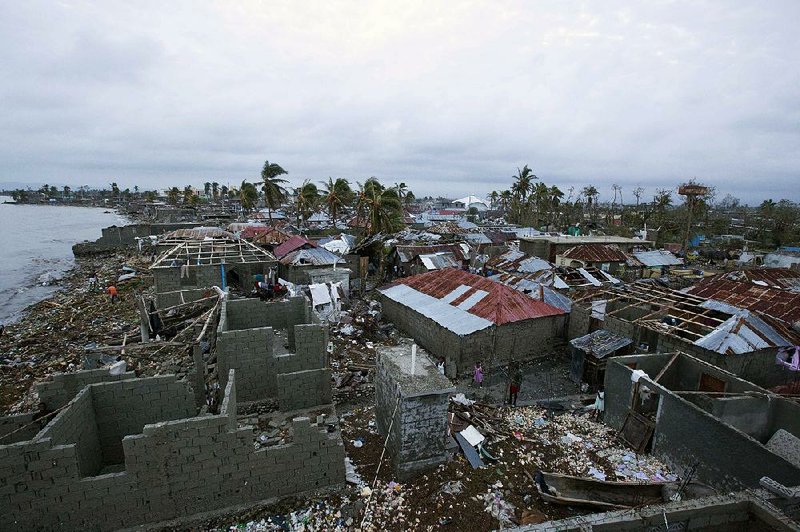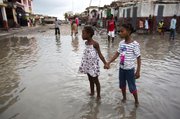LES CAYES, Haiti -- Haiti's death toll climbed Thursday as rescue crews began reaching remote corners cut off when Hurricane Matthew slammed into the country's southwest peninsula, the first Category 4 storm to hit Haiti in more than a half-century.
RELATED ARTICLES
http://www.arkansas…">Menacing Matthew marches onhttp://www.arkansas…">Ahead of Matthew, storm-surge flooding threatens lives, land along coast
http://www.arkansas…">2 state nonprofits assess losses, start recovery in Haiti
Bodies started to appear as water receded in some areas two days after 145 mph winds smashed concrete walls, flattened palm trees and tore roofs off buildings, forcing thousands of Haitians to flee. At least 283 people were reported dead in Haiti, an Interior Ministry official said Thursday night, and authorities expected the number to rise.
Those killed included a woman and her 6-year-old daughter who frantically abandoned their flimsy home and headed to a nearby church to seek shelter as Matthew roared in early Tuesday, said Ernst Ais, mayor of the town of Cavaillon.
"On the way to the church, the wind took them," Ais said.
At least 12 people died in his town, and Ais said he expected that number to increase.
Officials were especially concerned about the Grand-Anse area at the northern tip of the peninsula, where 38 of the known deaths were reported.
"Devastation is everywhere," said Pilus Enor, mayor of the town of Camp Perrin. "Every house has lost its roof. All the plantations have been destroyed. ... This is the first time we see something like this."
A helicopter tour Thursday of the port city of Les Cayes on Haiti's southwestern coast showed extensive damage, with cinder-block buildings knocked to the ground and metal roofs peeled back like tin-can lids or shorn completely off.
Everywhere, trees were flattened, and the main river that runs through town was swollen to the top of its banks and running the color of milk chocolate.
People faced an immediate hunger crisis in Grand-Anse's largest city of Jeremie, said Maarten Boute, chairman of telecom Digicel Haiti, who flew to the city in a helicopter.
In the seaport of Les Cayes, many people searched for clean water as they lugged mattresses and other belongings that they were able to salvage for the wreckage.
"Nothing is going well," said Jardine Laguerre, a teacher. "The water took what little money we had. We are hungry."
Authorities and aid workers were just beginning to get a clear picture of what they fear is the country's biggest disaster in years.
"Flying over, we were able to see quite a lot of destruction. Storm surges, downed trees, crop damage, farm damage. Roofs that had been clearly blown off of houses and buildings," said Margaret Traub, head of global initiatives for International Medical Corps, who landed in Les Cayes with two other colleagues and a journalist Thursday afternoon. "If I had to estimate, I would say at least 80 percent of buildings saw damage. Many of them were destroyed."
At least three cases of cholera were reported in Jeremie on the southwestern tip of Haiti, said Holly Frew, a spokesman for the aid group CARE in the Haitian capital, Port-au-Prince.
Cholera, a potentially deadly disease spread by contaminated water, is a main concern for relief agencies struggling over how to get clean water and emergency sanitation systems to areas now accessible only by air.
"We're very concerned about access to clean water," Traub said after an initial assessment. "We're concerned about the spread of disease. Cholera has been endemic, we're concerned about an uptick in cholera cases."
The interior minister said food and water were urgently needed, noting that crops had been leveled, wells inundated by seawater and some water-treatment facilities destroyed.
Before hitting Haiti, the storm was blamed for four deaths in the Dominican Republic, one in Colombia and one in St. Vincent and the Grenadines.
As of late Thursday, there were no reports of casualties on the better-equipped Cuba or the Bahamas, which was pummeled by the hurricane earlier Thursday.
There was wreckage and misery everywhere in Haiti's southern peninsula towns, where Matthew hit around daybreak Tuesday.
"The floodwater took all the food we have in the house. Now we are starving and don't have anything to cook," farmer Antoine Louis said, standing in brown water up to his thighs in the doorway of his deluged concrete shack.
In Aquin, a coastal town outside Les Cayes, people trudged through mud around the wreckage of clapboard houses and tiny shops.
Cenita Leconte was one of many who initially ignored calls to evacuate their vulnerable shacks before Matthew roared ashore. The 75-year-old finally complied and was thankful that she made it through the terrifying ordeal with her life.
"We've lost everything we own. But it would have been our fault if we stayed here and died," she said as neighbors poked through wreckage hoping to find at least some of their meager possessions.
The government has estimated at least 350,000 people need some kind of assistance.
International aid groups appealed for donations for a lengthy recovery effort in Haiti, the hemisphere's least developed and most aid-dependent nation.
When Category 4 Hurricane Flora hit Haiti in 1963, as many as 8,000 people died.
In coming days, U.S. military personnel equipped with nine helicopters were expected to start arriving to help deliver food and water to hard-hit areas.
Matthew slammed the Bahamian capital of Nassau on Thursday with winds of 140 mph.
There were no immediate reports of casualties in Nassau, but the storm ripped off roofs, uprooted trees and caused flooding that trapped some people in their homes. Authorities urged people to stay indoors while they conducted search and rescue operations.
In Cuba, Matthew blew across that island's sparsely populated eastern tip, destroying dozens of homes and damaging hundreds in the island's easternmost city, Baracoa. But the government oversaw the evacuation of nearly 380,000 people, and extensive measures were taken to protect communities and infrastructure, U.N. officials said.
Matthew's strength dropped slightly to a Category 3 after the storm crossing land in Haiti and eastern Cuba, but strengthened again to a Category 4 as it headed for the U.S. East Coast.
Information for this article was contributed by Pierre Richard Luxama and David McFadden of The Associated Press; and by Joshua Partlow, Paul Schemm and Brian Murphy of The Washington Post.
A Section on 10/07/2016

